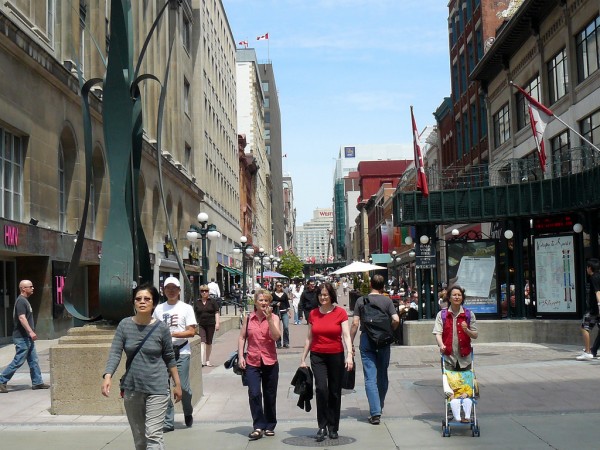At the heart of the city lies a stretch of paving stones, an open top pedestrian mall that in any European city would most likely be full of street vendors, casual strollers and whiffs of fancy coffees. Ottawa’s Sparks Street, largely owned by Public Works and the National Capital Commission, however, has become a no-mans land of tiny shops, empty restaurants and public art hardly seen by said public. Save for the lunch hour rush from the surrounding office towers or the occasional fire drill at the NCC, which uses it as a meeting place, the street lies empty during the week, despite its silent potential. So where is the street life needed to populate Sparks to a level where it feels safe, exciting and inviting? Why has a place of prime real estate and urban value in the heart of the city been left to become a non-place void of experience?
The idea of the “pedestrian street” is as old as the city itself, and has recently been a part of an urban revival of sorts as walking becomes more prevalent and promoted as a way to help combat both the environmental and obesity crises. But walking has also had a fashionable and political history, from the Flâneurs of Paris to the modern day psychogeographers of London; for it is in urban public spaces, such as the pedestrian street or covered arcade, where we rub shoulders with both the familiar and the foreign parts of our cities and society. It is where we come to see and be seen as we go about our daily routines and extracurricular adventures.
Spark’s dire situation is well known. There have been criticisms of over imposing street clutter (with café tables, sculptures and signage interrupting the flow of people who are left to dodge hard objects in their path) and the fact that there are no real large business draws (Zellers having been the closest thing to a pull, and which will soon be replaced by Toronto-based restaurant The Bier Markt). And neither is there enough of a boutique-store or “cultural hotspot” vibe to attract either people or dollars, and to make matters worse, Sparks is often a dark, windswept tunnel starving for sunlight.
But this is not to say Sparks Street is not trying to reinvent itself. A quick visit to the Street’s website would leave you wondering why it often seems so desolate with its advertised festivals, live entertainment and a New Years Eve party billed as a “Time Square experience”. Stop by during Rib Fest or the Busker Festival and you will have a hard time even finding a place to rest your overflowing container of barbequed meat.
Perhaps then, it is more of an urban design than programming issue that is the demise of Sparks Street. It is easy enough to fill a space but how do we make it a meaningful experience rather than one based solely on entertainment. How do we (re)design and create a place that allows for both planned as well as impromptu performances, experiences and simple everyday life? Perhaps Sparks suffers most greatly from the fact that there are few residential units in the area, being heavily surrounded by office towers and government buildings, and thus is almost deserted past the evening rush hour. Also significant is the fact that there is no meaningful end to the pedestrian path, which starts purposefully at the War Memorial and with close proximity to the bubbling Byward Market, but dissolves into a vehicular road at the Memorial Arch on Lyon, an urban monument which is hardly even mentioned in Ottawa culture or registered in our psyche. In short, there is no real reason for someone to continue down Sparks, save for returning to their hotel or to catch a bus on Bank Street. So is it a geographical, urban design or business flaw? What will save Sparks and return it to its former glory of 1961 when, according to the Sparks Street Mall website, “The plan was a huge success and it convinced the City of Ottawa to permanently close the street to vehicles creating North America’s first permanent outdoor pedestrian mall”? That is a pretty impressive claim to fame. So why the fall from grace?
Sparks Street and its unrealized possibilities need to be explored at both a planning and community level – a project perhaps best left to the imaginative minds of design students and town hall meetings, with ideas of movement and play at the heart of the competition brief. An urban intervention of sorts that will restore Sparks to a dynamic hub of activity and experience and a place in the Nation’s Capital that works both on the scale of national civic pride and local neighbourhood joy. A place all Ottawans and Canadians alike will want to visit and return to. A place with an identity and character. A place with a spark.


One comment
Nobody lives there. All of the residential is basically south of Laurier and west of Kent. To the east, the first building is 700 Sussex. The market and Elgin work because there are tons of nearby residential buildings. There needs to be a critical mass of people already filling in the baseline demand for some of these places so that if people venture in from several blocks away they know they wont be going to a ghost town.